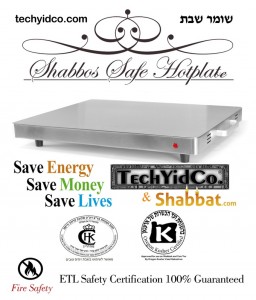The Latest in Shabbos Tech

When Ben-Tzion Davis, a Ger Tzedek and self-described electronics nerd, opened a standard Shabbos hotplate to help a friend, he was shocked to discover what was inside. His friend could easily have been more shocked than he was — literally.
Ben-Tzion set out to build a better model, founding a company called TechYid Co. His Shabbos Safe Hotplate uses a safe heating element and has a built-in fuse to protect from shocks or fire if anything goes wrong. This is a brilliant idea — but he needs funding to make his new hot plate a reality, and his KickStarter campaign has only three days remaining. But, on the other hand, he has already raised over $58,000 of the $60,500 he needs.
[UPDATE: He made it. The Hotplate is funded, but you can still pre-order yours.]
So if you use a hot plate and are concerned about the safety of these devices, I urge you to check out the video for his Shabbos Safe Hotplate, and sign up to receive yours.


Please explain what the chiddush is here.
Hot plates have been around for decades. I grew up with a Salton hotplate (manufactured in the Bronx) in the 1960s.
So he put in a fuse? For that he needs $100,000?
If there is truly something revolutionary let it be made clear.
Rumor has it that the Sassoon fire started from their hotplate. I haven’t verified this, but… need I say more?
I think if you watch the video, it’s extremely clear. The heating element is more like those found in electric ovens than in other hotplates, and this is apparently much safer as well.
Conventional units were not made for the frum community in particular — meaning, they were not necessarily designed to be left on for 25 hours straight, including unattended overnight. This unit really is much safer, and because it’s an innovative design it takes money to launch it.
What exactly is it about a normal hotplate that makes the duration of its use a factor at all? What duty cycle is checked out when UL or some similar lab tests one before declaring it safe? In the testing, does it reach the same peak temperature that it would reach over Shabbos or not? Or is the problem more that it needs a heavier duty power cord?
It appears quite different then many old US hotplates that operate at lower temperatures and the Israeli plattes that run at higher temperatures and i suspect are (much) less safe. I suspect in many densely jewish communities the hotplates sold in local stores are more similar to a platte. if i am correct, this much higher temperature has other halakhic implications.that Americans may not be as familiar with. consult with your local halakhic authority on any restrictions that might apply.
kol hakavod – this is much less expensive than a warming drawer, with its own set of sheailot.
The Israeli plattes do run much hotter and are a lot less safe. I have had one melt it’s feet and then start melting it’s frame. We once left another one on a wooden table during Shabbat and it scorched and ruined the tabletop. We definitely can use a safer platte like this one.